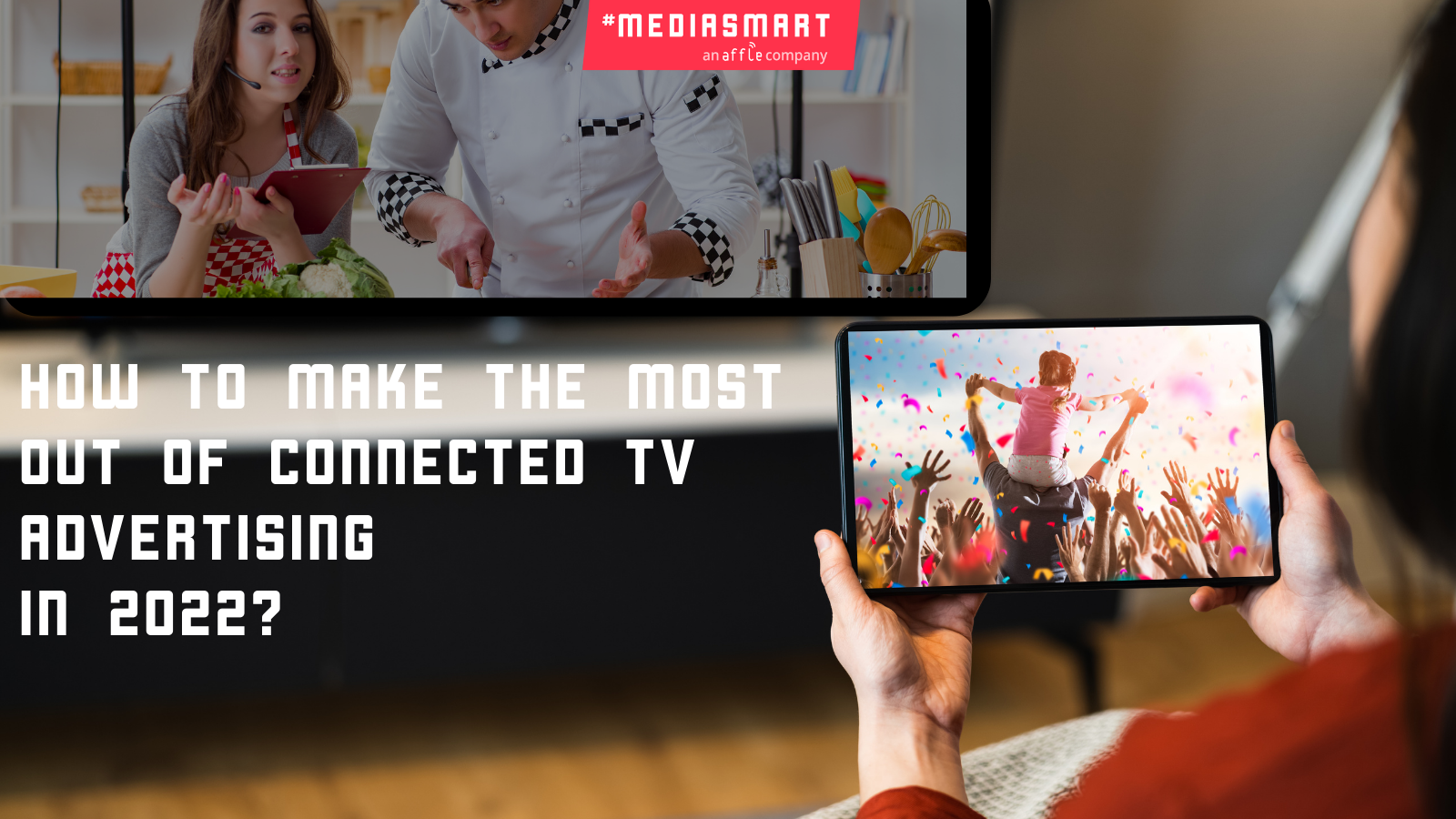Blog
Announcements, analysis and opinions on industry trends around the mobile programmatic world.

Subscribe now, and receive the latest programmatic content directly on your inbox!
Thank you for subscribing to our newsletter
According to the (IAB), Connected TV (CTV) advertising will reach 21.2 billion US dollars in 2022, growing by 39% compared to 2021. CTV viewing is becoming dominant, even in developing countries, because the user experience in CTV is leagues above traditional TV.
It's no wonder that brands are investing more in CTV advertising as both the user and advertiser experience are outstanding. Advertisers are increasingly aware of the many benefits this medium offers. First, there are fewer budget constraints, whereas, in traditional TV, minimum spending requirements have always been high. Advertisers can measure actual media consumption while buying programmatically. With an advanced technology partner, such as mediasmart, the possibility to create rich marketing strategies by targeting other devices within the households that were already impacted by ads also becomes a reality. And, to top it all, it allows real-time optimization to maximize conversion rates.
The acceleration of Connected TV (CTV) is a well-established fact within the advertising industry. As Connected TV continues to grow, so will the advertising. This article covers five areas any CTV advertiser should consider to launch a successful CTV campaign: how to pull the right levers to make the most of your CTV advertising budget.
1. Reach your target audiences exclusively to maximize relevancy
When you do any advertising, you want to reach the right people. The same is true and, more importantly, possible with Connected TV. Opposite to traditional TV, where ads are broadcasted in the open and impressions can't be measured accurately, Connected TV offers the possibility to target, retarget, or suppress particular devices from your marketing strategies—helping you reach only the specific audiences for your business. In addition, you will be able to identify unique CTV devices, either by where they are located, the brand of the device, or the apps used.
The industry has developed to the point where Data Management Partners (DMPs) have made available audiences for Connected TV. This is the case with our partner, Digiseg, and their GDPR-compliant IP-based audiences. With them, you can target households with certain income or savings levels, neighbourhoods or home types, certain tech-level in the households, and the number of children or cars per household, among other things.
In mediasmart, our usual audience management capabilities - like Interaction-based audiences - will work on Connected TV. Still, we have also developed cross-screen capabilities that will allow brands to find their mobile audiences on bigger screens. For example, this means that you could build a Location-based audience around the financial area of the city you are targeting that would feed on the mobile devices around that particular area. Instead of targeting them on their smartphones, you could target them once they are back relaxing at home. In reality, any of the following four ways: location-based, time-based audiences, interaction-based, or audiences from third-party sources, are available to create cross-screen audiences with mediasmart.
Honing your targeted audience on CTV, either by understanding demographic and psychographic interests, retargeting previously engaged users or automatically blocking users that don't convert, will allow you to control your budgets and be more successful at measuring and driving up your ROI.
2. Dynamic Creative Optimization and Frequency Capping for a top-notch user experience
Traditional or linear TV advertising, while hugely popular, allows for limited optimization. For example, it will show the same ads independently of the household, and pricing will solely depend on TV Programmation. On the opposite end, CTV will allow advertisers to serve ads to the most relevant users, independent of the TV show they are watching. Not only through audiences, as explained above, but also through a better understanding of the target group. This is possible through Programmatic-driven Marketing and Dynamic Creative Optimization - allowing you to personalize your ads depending on the area, the closeness to the store, the number of your ads they have seen before, etc.
In truth, you could use a single-served ad only for particular targeting variables, but you could also go for Dynamic Creative Optimization, where the ad will automatically vary depending on the targeting variables. Let me give you an example: if you serve ads close to a store that closes at 19h, the ad could show, "To benefit from this promotion, come tomorrow before 19h!". And if the ad is served next to the store that closes at 22h, it will automatically change to: "To benefit from this promotion, come tomorrow before 22h!". This hyper-personalization will make your brand more likeable to the end-user.
Now that we are talking about creatives, it is crucial to speak about user fatigue. When a user is impacted by the same ad over and over, it could make viewers, at best, agnostic to the message and, at worse, generate a bad predisposition to the brand.
What could be worse than to hear your prospect say, "I've seen these ads so many times it's annoying... I don't want anything with this brand". Love is a fickle thing among consumers.
You are probably wondering if there is anything to be done to avoid that scenario? The answer is yes! Frequency capping is available for Connected TV. You won't have to rely on the user watching or not a particular channel or show at a specific time to see your ad, but you can decide the number of times you want to serve an ad on a particular household. This will control the users' fatigue and positively impact your return on investment as it gives you the means to prevent ad wastage.
3. Maximized reach and interactivity with Household Sync
'TV syncing' has been "a thing" in the Advertising industry for a long time. In the past, when you wanted to do that type of synchronization, companies would launch a mobile campaign indiscriminately at the same time they expected their commercials to air on traditional TV. However, as technology improves, Connected TV, when paired with the right tech partners, like mediasmart, makes it possible to generate a full-funnel approach. It stops being a game of hard guessing. Now, you can target the biggest screen with a cinematographic spot and then target connected devices, like smartphones or tablets, within the same household with an ad where interaction is easy for the end-user; making purchases, for example, more likely.
One of the biggest draws of CTV advertising for advertisers is its ability to combine the twin strengths of the engaging storytelling associated with TV advertising and the targeting and measurability associated with programmatic advertising. To top it all, mediasmart's Household sync adds to that beautiful mix, the intrinsic interactivity in mobile devices. It will also make it possible to set a window of opportunity between the ad served on a CTV and the ad on a mobile or a tablet. There could be up to 9 different possibilities between thirty seconds and ten days after the CTV ads are shown.
What better than a cross-screen marketing strategy, topped by the measurability, granular reporting and real-time optimization capabilities that are characteristics of Programmatic media buying to maximize your advertising budgets?
4. Contextual Connected TV for optimal placement
With hundreds of players, the emerging Connected TV (CTV) landscape creates unique and complex global challenges for advertisers. While many current CTV targeting solutions are manual, Peer39 has developed an automated solution catered for CTV that mediasmart has integrated.
When you switch from a paradigm that is centred on what show is being shown on the screen to centring your marketing efforts on particular devices, the importance of understanding where your ad is being served skyrockets. Contextual Connected TV does just that: it will give you context on what shows your ads are preceding or concluding. CTV advertisers can identify how many OTT requests are available across each OTT service or device, a particular network or cable channel, target the inventory by content category, and avoid unsuitable content.
Not only that, but you can also pair it with other types of Contextual targeting, such as Weather targeting, which means that you could choose to serve your ads on rainy days and not only when you expect people to be at home, like early morning or late at night. As less advertising budget is wasted, this is another area that will help you ace your CTV campaigns.
5. Data-driven decisions unlocked thanks to Connected TV
As stated several times in the article, one of the drawbacks of TV advertising was the lack of control and understanding of the return on investment of the advertising budgets. Programmatic buying of TV ad spaces makes it much more effective for modern-day advertisers like you.
Even when buying through Deals, you will have access to many KPIs if you are buying your CTV ads programmatically.
Not only will you have much more precise management of when and where your ads are being served, but you will also be able to pair those impressions with actions that your target group are performing, be it on the net or in "real life". For example, tracking and attribution will help you understand which impressions generated app downloads, e-commerce conversions or actual in-person store visits.
You might wonder what conversion types could happen and be tracked from CTV ads. We can separate four different types of conversions:
- CTV to mobile, where users watch an Ad on a CTV and then download an app on their mobile devices; fill out a lead-gen form on their mobiles or make a purchase through their phones.
- CTV to CTV, where users watch an ad on CTV, and they download an app on the actual Smart TV. It is self-evident when we speak about VOD apps like Netflix, Discovery +, HBO or Hulu, but it is also true for gaming apps that are getting more popular.
- CTV to the physical world. You place an ad on a CTV, and mediasmart's technology will help you measure the in-store visits that the CTV commercial generated. This is what we call drive-to-store from CTV ads.
- Scanning QR codes on CTV ads. Those are trackable when opened on a smartphone or tablet.
As you can imagine, this opens up a whole world of possibilities through automation. For example, you could use your media buying platform's algorithms to optimize lead generation, app downloads or store visits; and make your budgets work for you without lifting a finger.
Unquestionably, the most innovative way to invest your advertising budget.
As the medium continues to mature, savvy marketers will optimize their campaigns well-equipped to capitalize on this new way to engage customers. We hope these five key considerations to make the most out of CTV in 2022 will help you master CTV advertising.
If you have any questions or suggestions, please, don't hesitate to contact us!
Topics: connected tv
%20(1).jpg)

